The F.P. Journe Automatique Limited Edition, For the 20th Anniversary Of The Octa
An exclusive and superb watch that pays tribute to early Octa models by Journe.

If François-Paul Journe’s first prototype wristwatches were made in the early 1990s, the eponymous brand itself was officially created in 1999, with the introduction of a collection of hand-wound chronometers, such as the Tourbillon Souverain or a year later the Chronomètre à Résonance. From that moment, things went fast for Journe, who launched the Octa collection in 2001, the third model of the brand, but mostly the first with an automatic movement – and one that was able to perform for up to 120 hours with guaranteed chronometric accuracy. The Octa movement will become the base of an entire collection for the next two decades. And as it celebrates its 20th anniversary this year, F.P. Journe introduced the Automatique Limited Edition, a superb tribute to the Octa original model, with multiple design and finishing references to please seasoned collectors.
The 20 years of Octa and self-winding watches
In the first two years of existence of his eponymous brand, F.P. Journe managed to impress the watch community with two watches that will become some of the most respected models in modern horology. In 1999, as a premiere for the brand, Journe unveiled the Tourbillon Souverain, a watch with a tourbillon regulator accompanied by a constant force mechanism, his emblematic remontoir d’égalité. A year later, Journe came with an equally important watch, a model that summarized his research into the phenomenon of resonance that he started in 1983, the Chronomètre à Résonance – being the first implementation of this concept in a wristwatch.
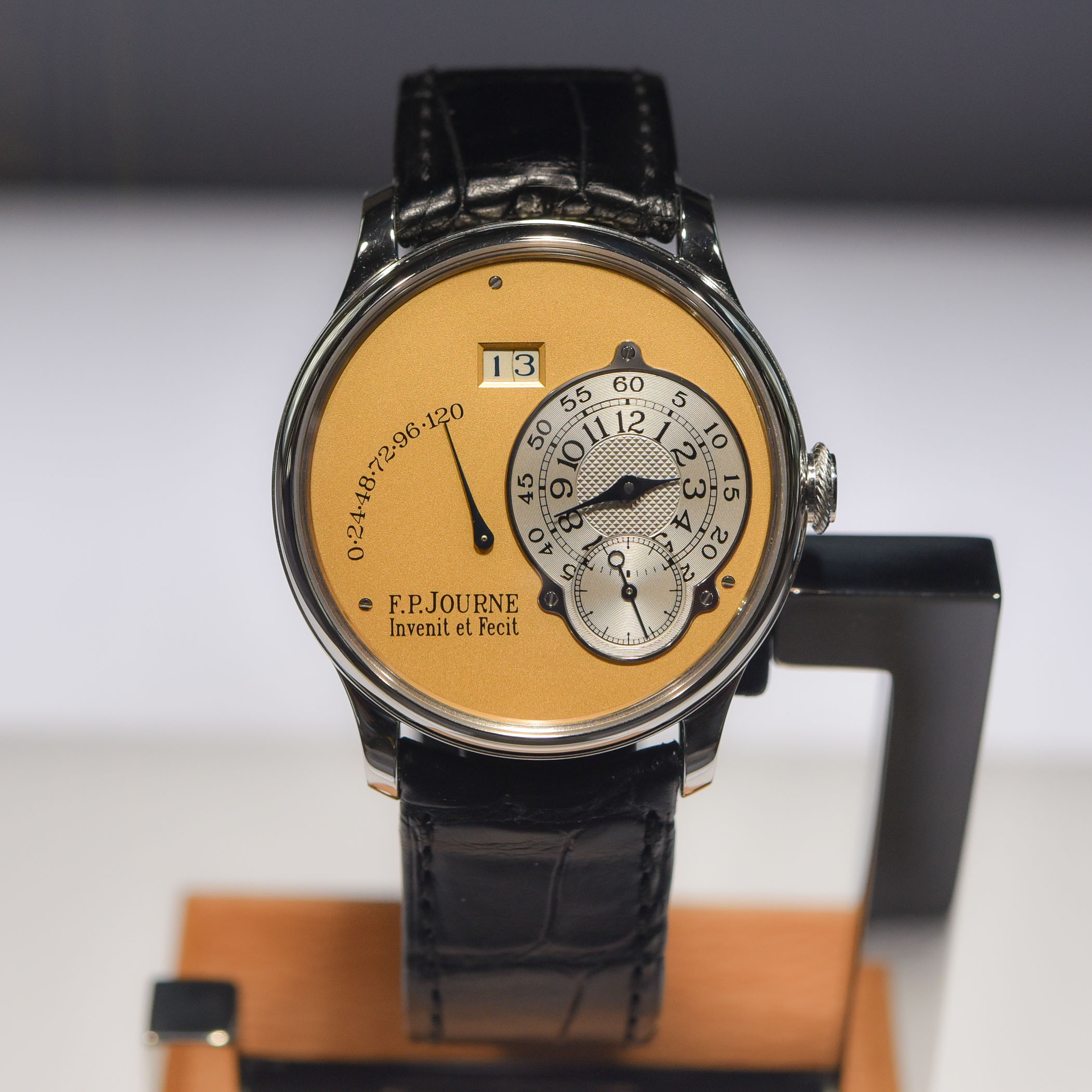
The octa movement
For his third watch, François-Paul Journe had something different in mind. The idea, which traces itself back to around 1994, was to develop an automatic watch, as the convenient and more wearable side of the brand. Yet, there was no possible compromise on chronometry. To achieve this, Journe had to develop an entirely new calibre, which will later be known as the Octa. Development began in 1997 with a presentation of the inaugural Octa Réserve de Marche in 2001.
As an accomplished watchmaker, Journe already knew the issues linked to self-winding movements. Automatic watches are the result of a need for convenience, by eliminating the need to wind the watch. For this, watchmakers have found ways to prolong the autonomy, using longer mainsprings, additional barrels, and smaller balance wheels, all of which achieve better autonomy but at the risk of losing precision. The challenge for Journe, with his Octa movement, was to find the balance between autonomy and accuracy. Still, the Octa movement began with an 8-day power reserve, while it is known that the longer the mainspring, the higher will be the torque when fully wound, and the decrease will be equally strong as it unwinds. A nightmare when it comes to regulating the watch.
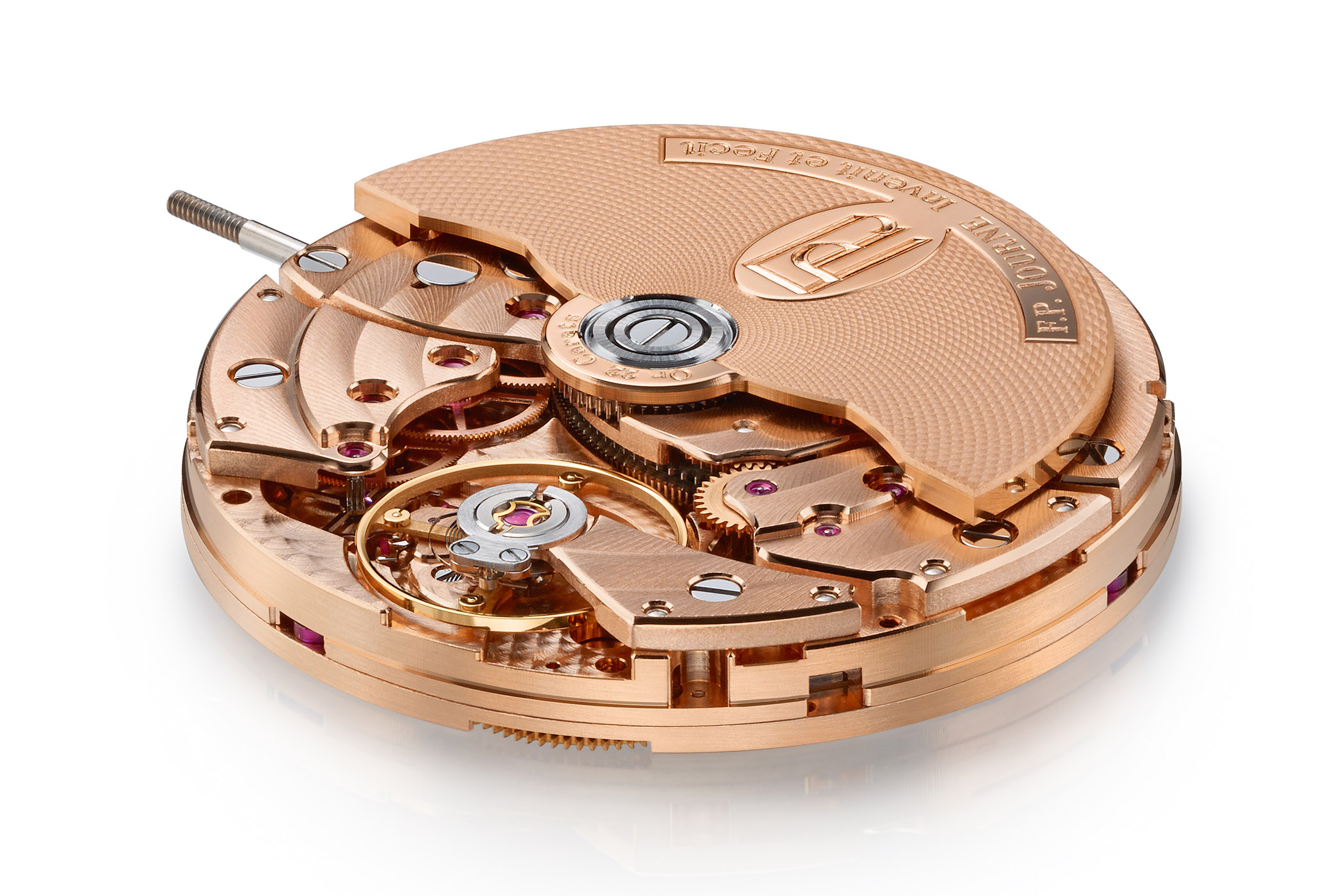
At the foundation of the Octa calibre, there’s a 1-metre long mainspring, in a single barrel where it is coiled 13.5 times, with two revolutions occurring every 24 hours. The result of such a setup was a very linear and stable energy supply over a period of 3-4 days, with a loss of energy not exceeding 20% over this period. A first step in balancing autonomy and precision. In addition to this, and because of the exceedingly long mainspring, Journe was able to fit a large balance of 10.1mm, while small balance wheels are generally preferred in automatic movements because they require less energy to oscillate. But larger balance wheels, when regulated properly, offer much better stability than smaller ones.
As for autonomy, the original Octa calibre was intended to have an 8-day power reserve. Yet, tests after tests, Journe found that this extended power reserve was competing with precision and winding speed factors. It was not worth sacrificing precision for additional autonomy, so 7 days was decided to be adequate. And why the Octa has a power reserve graduated to 120 hours on the dial when it can run for 150-160 hours? Simply because the most stable chronometric performance is delivered during the first 120 hours of run, being the optimal range for the wearer.
The final step in the Octa movement was to revise the automatic winding system to be highly efficient, making it easier to maintain the optimal torque with such a long power reserve. For this, Journe designed a 22k gold rotor that was about three times more efficient than the rotor of an ETA 2892. And if you wonder why the rotor is slightly off-centred, it was for “the ability to pass a pinion through the movement without obstructing the rotor. This pinion would serve as a transmission, allowing François-Paul to make a double-sided watch should he want to, with complications on both sides, (as he) initially planned to develop a sky chart complication on the backside of an Octa.”
The first Octa RDM watches
At the 2000 edition of Baselworld, F.P. Journe presented three models – the Chronomètre à Résonance, the Tourbillon Souverain (launched 1999), and a unique Grande Sonnerie piece – along with three prototypes of three upcoming models – the upcoming Octa Réserve de Marche, Octa Chronographe, and Octa Calendrier, all in platinum with a yellow gold dial.
Three prototypes of the Octa RdM were created, all with functioning movements, but still with flaws. These three watches include a smaller font used for the power reserve, the larger date discs, and the larger seconds subdial without the 5th and 7th hour printed. Two of these watches were later gifted to members of the F.P.Journe Board of Directors. François-Paul Journe changed the dials and date discs to make them more reliable and wearable, as well as engraved the movement with the typical movement labels of the Octa. The last and third prototype was François-Paul Journe’s personal watch and remained in his drawer for some additional years before finding its way into private hands, but this one remained fully unchanged. One of the three watches, visible on the photos above, was auctioned by Phillips in 2019 and sold for USD 250,000.
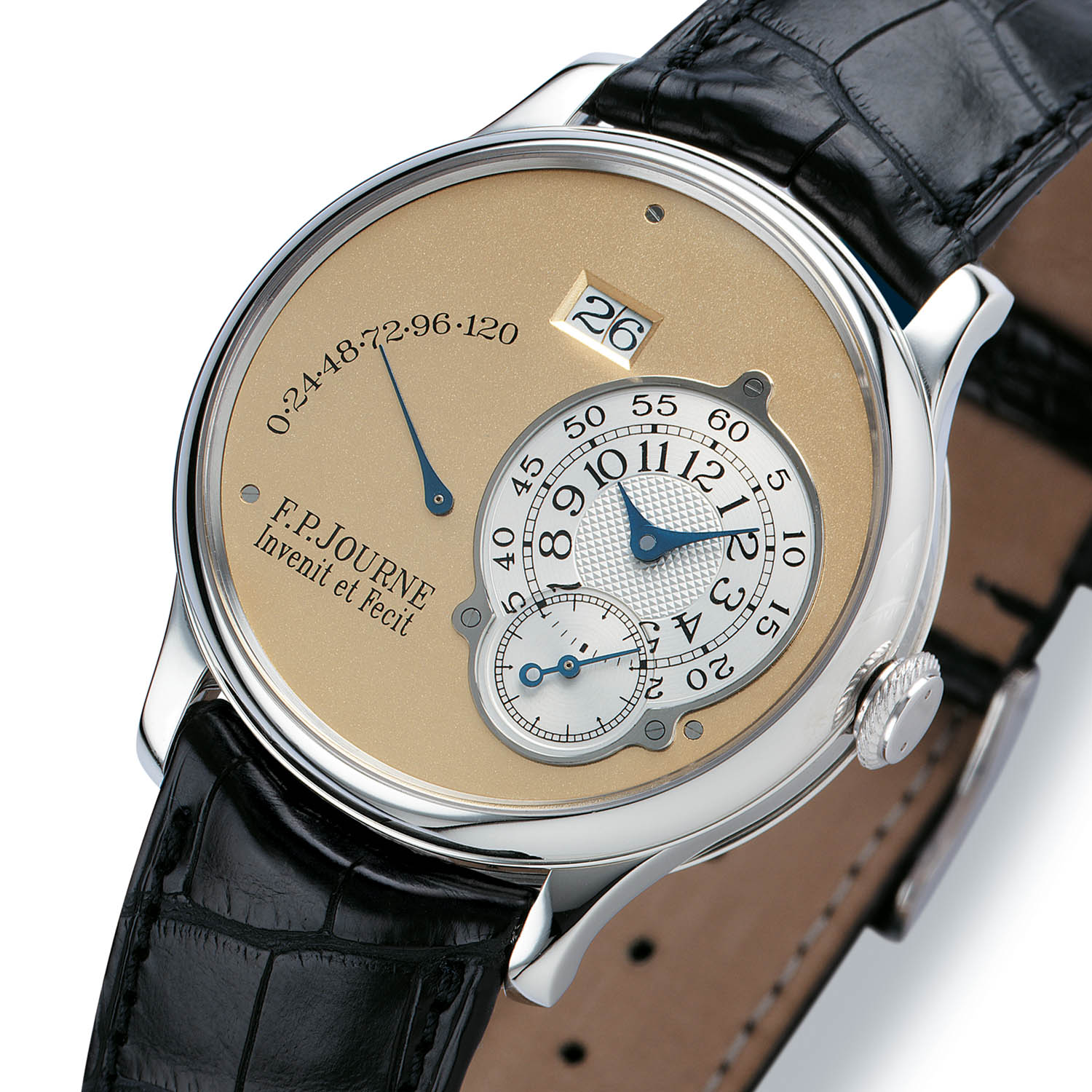
In 2001, the Octa Réserve de Marche was finally ready for production and commercialization. Compared to the prototypes, some (minimal) changes were made, such as revised date components and discs, both improved mechanically and aesthetically to be more reliable, the power reserve printings were enlarged and the subdial was slightly redesigned to be smaller and more elegant, and the 5 and 7 markers were partially printed. 5 different combinations were available, all in 38mm cases in platinum, 18K rose gold or 18k white gold, with 5N gold or white gold dials, the yellow gold dial being exclusively available on a Platinum case.
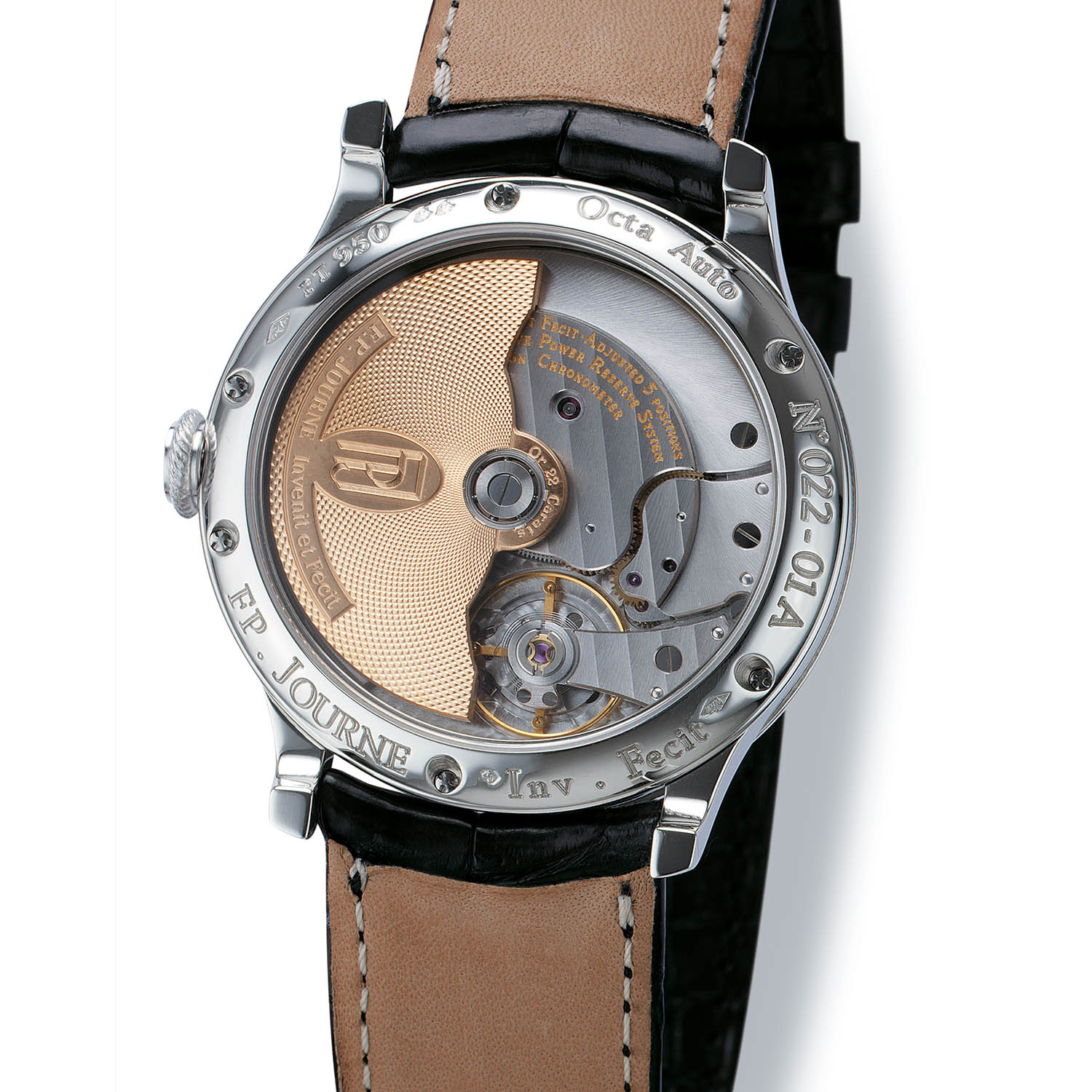
The first models of the Octa Réserve de Marche were equipped with what collectors name early dials, known for having different textures and colours, most notably with their shimmer. Back in the days, Journe was still outsourcing dials, which often lead to inconsistent characteristics among the early dials. Also, the earliest models feature a movement that was (of course) made in brass, yet with straight Geneva stripes, instead of circular ones on later editions.
One of the most important steps in F.P. Journe’s production occurred in 2004, when he started to make plates and bridges in 18k gold – an ode to his prototype wristwatch in 1991, where the movement was made of gold. To mark this occasion, Journe presented the second-generation Tourbillon Souverain (with dead seconds), the first model to have a movement crafted from 18k rose gold. Journe also discontinued the production of brass movements and shifted the entire baseplate and bridge production in-house, crafting them from 18k rose gold. This second execution of the Octa Réserve de Marche (2004-2016) thus came with calibre 1300.2, instead of calibre 1300 – with the only difference being in the materials. Also, 5N gold was replaced by 6N gold for cases and dial, an additional 40mm version was available, and the yellow gold dial was not available anymore. As such, early watches with yellow gold dials and brass movements have become highly collectable – about 2,000 brass movements across all models have been produced between 1999 and 2004.
Editor’s note: we’d like to thank Osama Sendi (a.k.a @thejourneguy) for his contribution to the historical part of this article.
The F.P. Journe Automatique Limited Edition
So after this relatively long introduction to the Octa movement and watches, it’s time to look at this new – and sadly already unattainable – F.P. Journe Automatique Limited Edition. The introduction was necessary to really understand what makes this watch so special, especially in the heart of Journe’s collectors.
What is this watch all about? In (very) short, it is an ode to the earliest generation of Octa Réserve de Marche, namely the 2001 model or even the prototypes. Some details have changed and been modernized, yet there are important features of this watch that directly refers to the earliest editions, and which are rarely (if never) seen anymore in the brand’s contemporary production. And knowing the collectability of these early models, this limited edition, with multiple historic references, was destined to succeed – and its announcement has proven this right.
As for the habillage, the new F.P. Journe Automatique Limited Edition 20th anniversary sticks to the brand’s classic case, with a design that is basically the same since the inception of the manufacture; a domed bezel, a thin and knurled crown, a slightly recessed central container and relatively robust lugs. If the shape is anything but new, the diameter of the watch has increased since 2001, as this edition measures 40mm in diameter. Still, this is the smaller case available now from the brand – which also offers 42mm models. The height, as always with Octa watches, is relatively well managed, being 10.7mm. Nice proportions overall, with the right balance between presence and elegance. Would I have preferred a 38mm case? Yes, surely, mostly for historical relevance. But the 40mm case of Journe is known to be ergonomic.
As a reference to the inaugural model, the case is here made of platinum, finished with polished surfaces. The watch is worn on a black alligator strap, with alligator lining and a platinum pin buckle – all traditional for the brand. No fancy features, no deviation from the brand’s DNA, just a simple, elegant and restrained watch. On top is a slightly domed sapphire crystal and the caseback will let you see the movement, and is engraved with deep indications, again a classic F.P. Journe feature.
What truly matters with this F.P. Journe Automatique Limited Edition is not in the case or the strap. It is the dial and the movement. Both are directly inspired by the prototypes and the 2001-2004 generation of Octa Réserve de Marche. The Dial is made of yellow gold – which, as explained, was only available in combination with a platinum case and was discontinued a few years later. The movement is made of rhodium-plated brass… And that’s something unseen on the Octa movement since 2004. Even the superb set of 5 steel models to end the production of the 38mm case came with solid gold movements. In short, a combination that is simply striking for those in the know.
Let’s start with the dial, which is a direct tribute to early yellow gold dials at F.P. Journe – again, something that has not been seen in the collection for a long time. The base is indeed a matte, grained 18k yellow gold plate with a very attractive colour, which changes in an almost unbelievable way depending on the light conditions. Due to the finishing, and to the natural iridescence of the material, there’s an impressive shimmer on this dial. When under a smooth, diffuse light, the dial appears flat and pale yellow, with a silky texture. However, put it under direct sunlight and it reveals its texture and colour, with an almost bronze hue. This exact colour is only found on early, slightly patinated F.P. Journe watches and it is bringing in the context of this watch something exclusive and a slightly rough, “prototype-like” result. See the difference below…
For the rest, the dial of this F.P. Journe Automatique Limited Edition brings back the display found on the 2000 prototype and 2001 Octa RdM, meaning an off-centred dial on the right side, with a main hours and minutes counter and a smaller seconds counter underneath. In the same vein, the power reserve sits on the left side while the large date is somewhere at 11:30. But, this would be too easy… There are some discreet yet important differences between this watch and a 2004-2016 Octa RdM. If the display is identical, with a date window now measuring 4.7mm x 2.6mm, a power reserve indicator that has been moved down slightly, and numerals of the hour and minute dial that have also been enlarged, some elements are directly inspired by the 2000 prototype. First, the steel ring circling the time display has been reshaped to be identical to early models. Then, the numerals 5 and 7 have been removed, so as to be consistent with the prototype. And finally, the small seconds track is larger too.
For the rest, we’re in known territories, with a silver guilloché sub-dial with “clous de Paris” pattern, typical blued steel drop-shaped hands and a small seconds hand with opened-eye counterweight. As with most F.P. Journe watches, the display is voluntarily unbalanced and asymmetrical, bringing a lot of charm and distinctiveness to this watch. And the multiple small historical details make it very different from standard production, second-generation Octa Réserve de Marche – at least in the eyes of the brand’s fans.
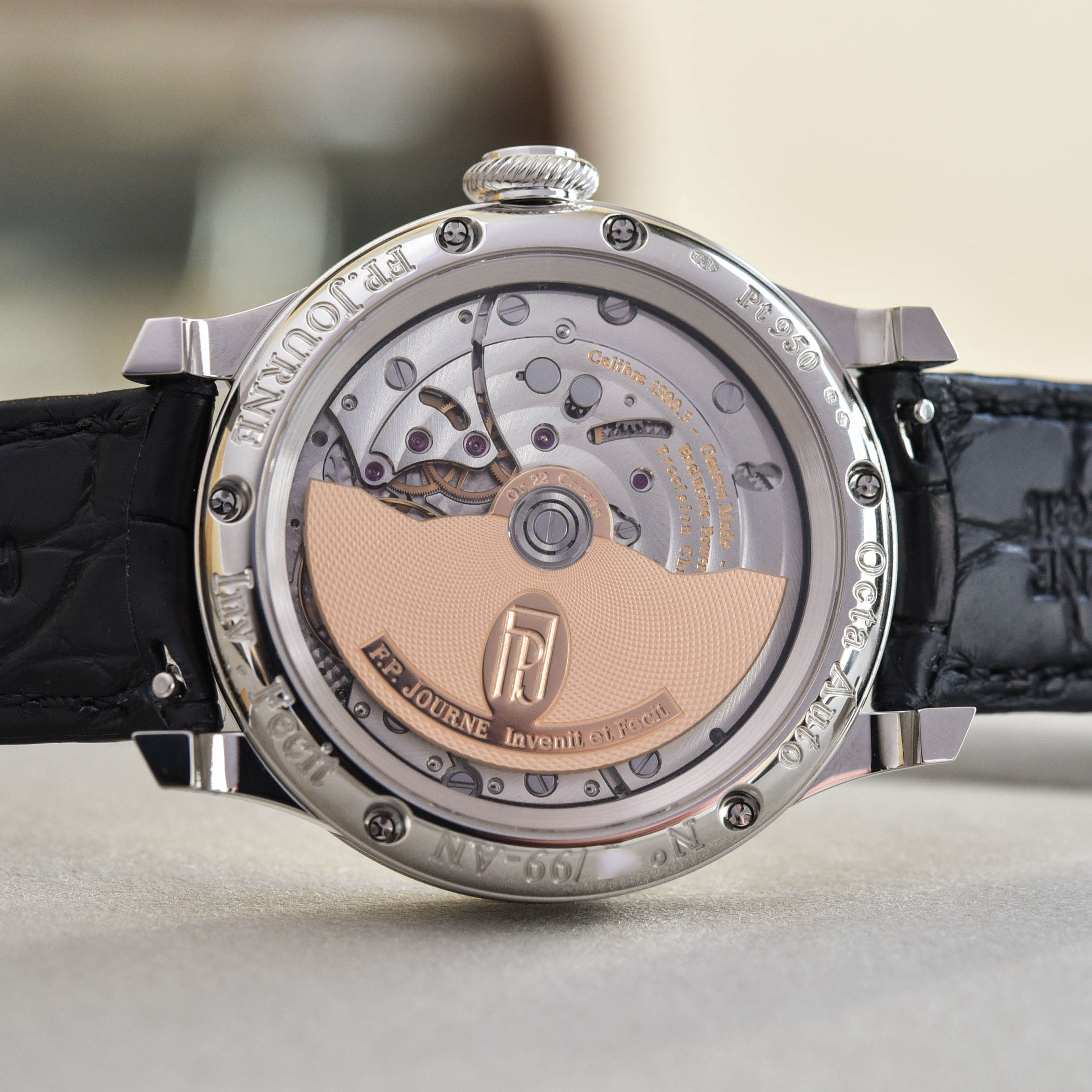
Turning the Automatique Limited Edition and you’ll discover the pièce de résistance, the main object of the crime, what will certainly drive most of the desirability here; a rhodium-plated movement made from brass. With most other brands, this would be seen as a step-down, a cost-cutting decision, a decrease in quality and prestige. But it’s F.P. Journe and the resurgence of a brass-made movement is a big thing. Some will find this odd, the brand’s fans will jump to the roof – and the future value of this edition is, believe me, expected to skyrocket because of that. So what we have here is the third generation of Octa calibre, the 1300.3, which only brings one slight aesthetical modification compared to the calibre 1300.2, as now decorated with openwork bridges. Other than that, it’s an Octa base.
As such, we have a large – 34.60mm in diameter – movement with its distinctive unidirectional, off-centred, 22K gold and guilloché rotor on top. It comes with all the usual features, such as the single barrel with an ultra-long mainspring, a large 10.1mm balance with four adjustable inertia weights, an anachron flat balance spring with an escapement running at a 3Hz frequency. The power reserve is announced at approximately 160 hours, even though the dial indicates 120 hours (for reasons explained above). All indications are adjusted by the crown, including the large date (2 non-overlapping discs) with instantaneous change. Finishing includes graining on the base plate, circular Côtes de Genève on bridges, rhodium plating over the brass parts, bevelled bridges, golden engravings, polished screw heads with chamfered slots and steel components hand polished and chamfered. But in the end, it really comes down to this silver-coloured movement…
Availability & Price
The F.P. Journe Automatique Limited Edition for the 20th Anniversary of the Octa calibre will be made in 99 pieces. It will be priced at CHF 56,000 (excl. taxes). But be aware that all examples have already been allocated…
The brand also indicates that the updated Automatique will later join the current collection with a 40mm or 42 mm case in platinum or 18k 6N gold, and a dial in gold and guilloché silver, yet without the brass movement. More details at www.fpjourne.com.

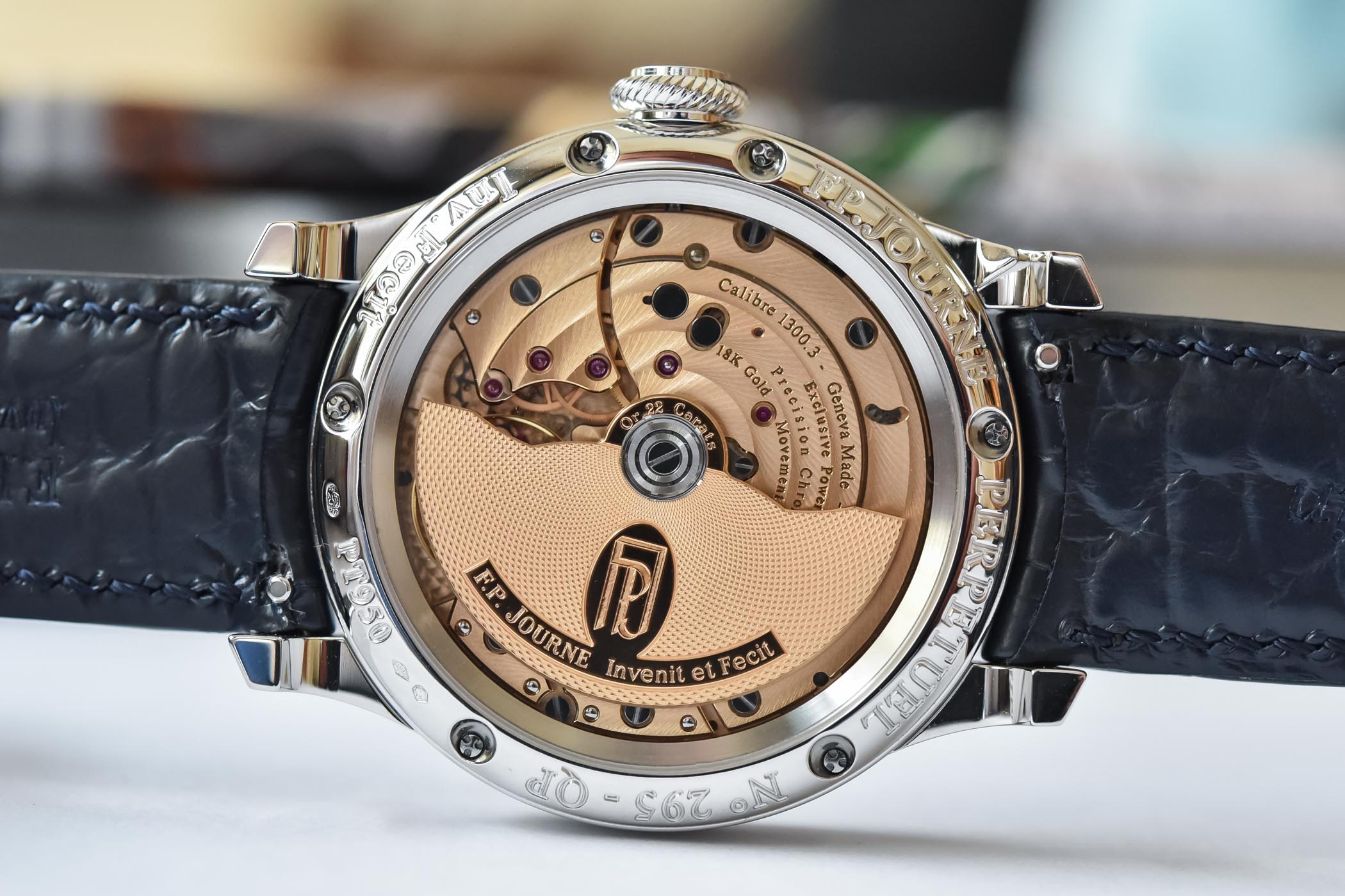
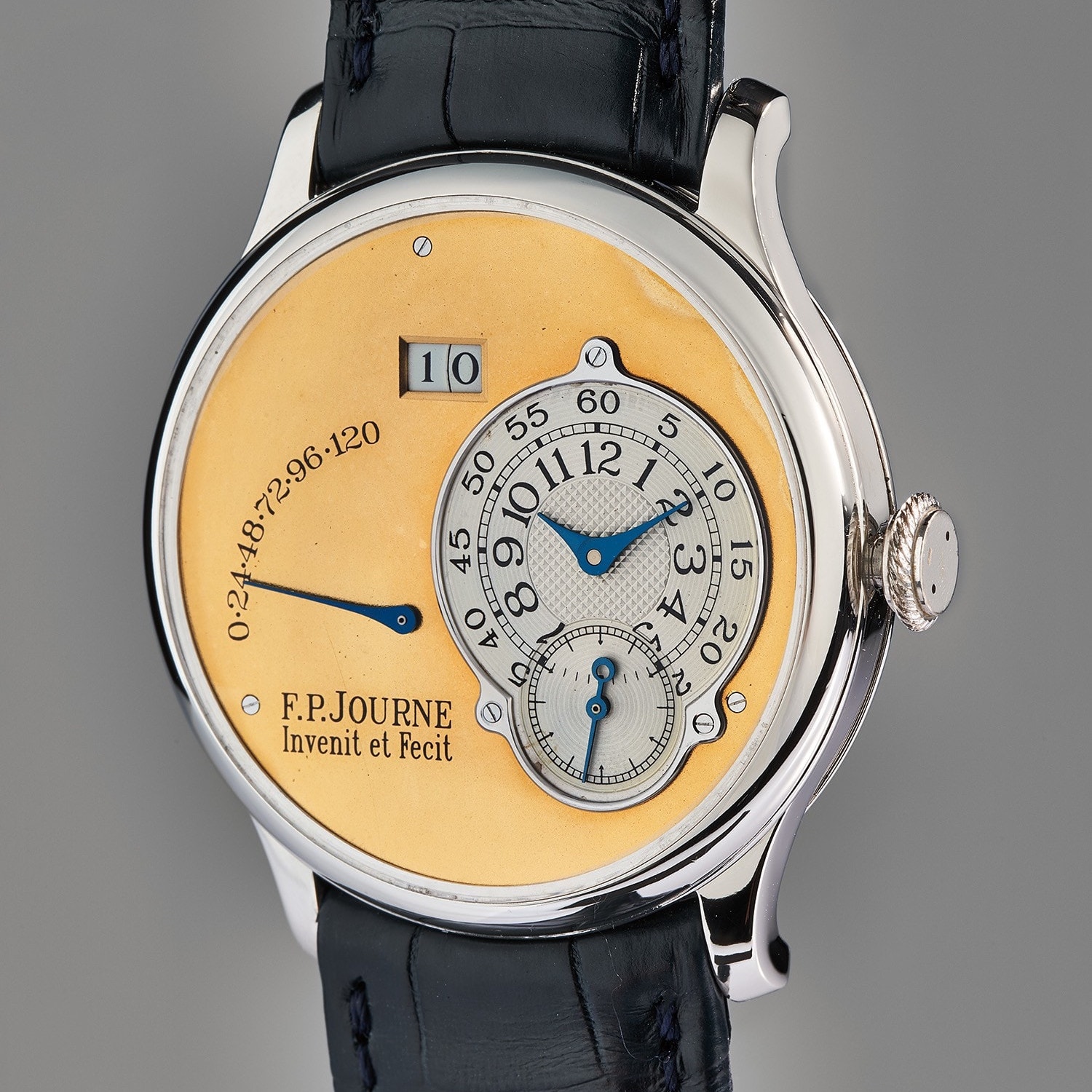
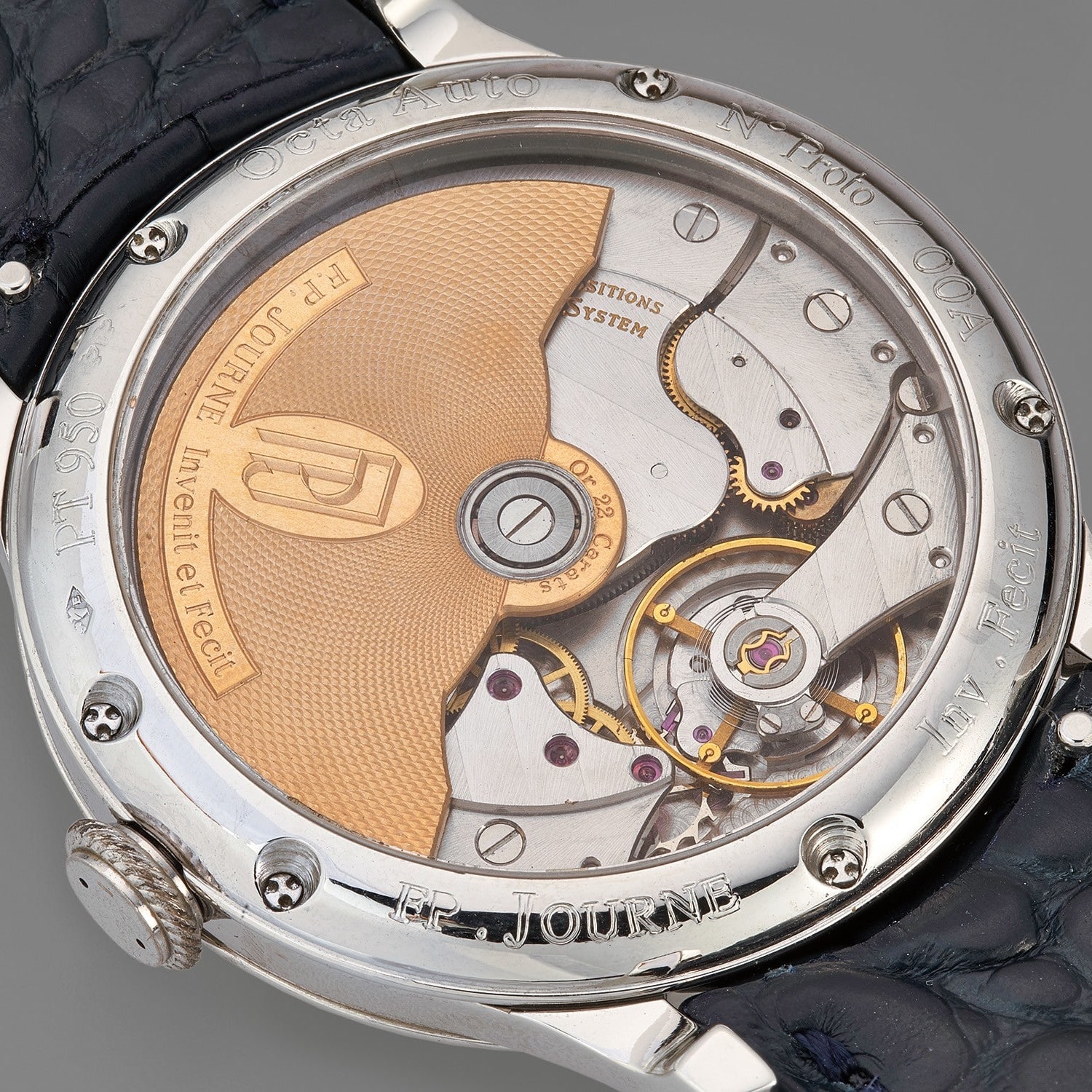

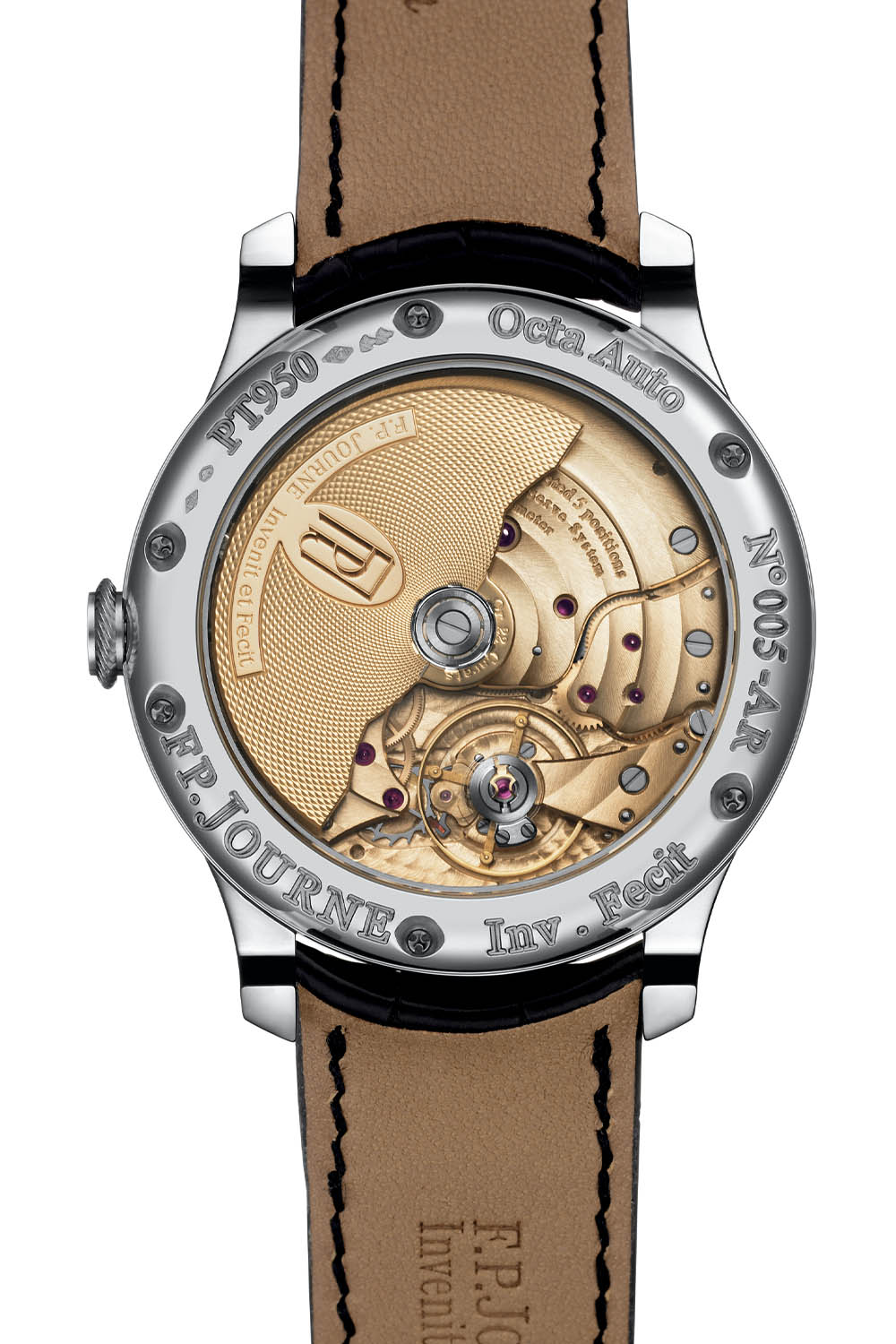
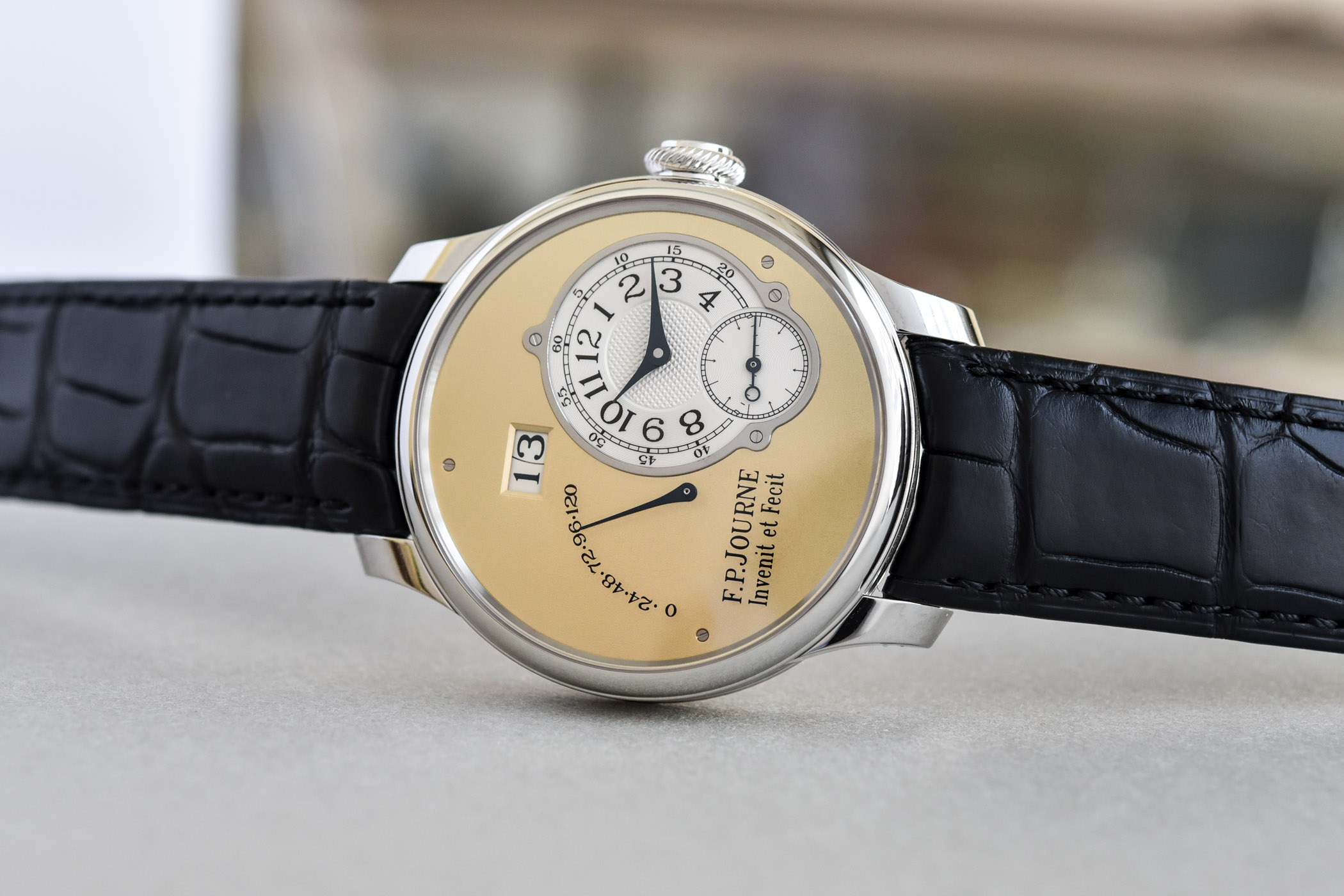

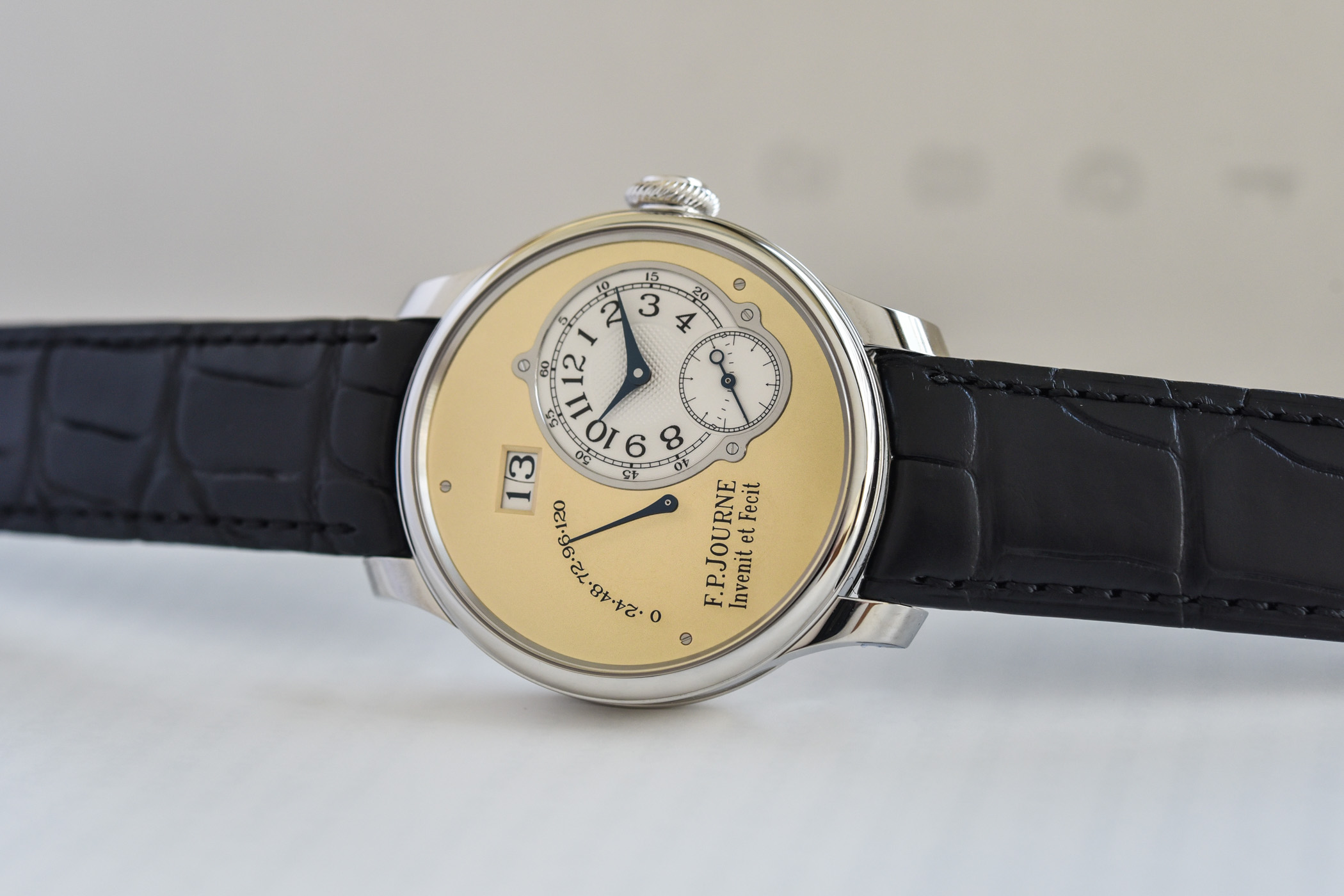
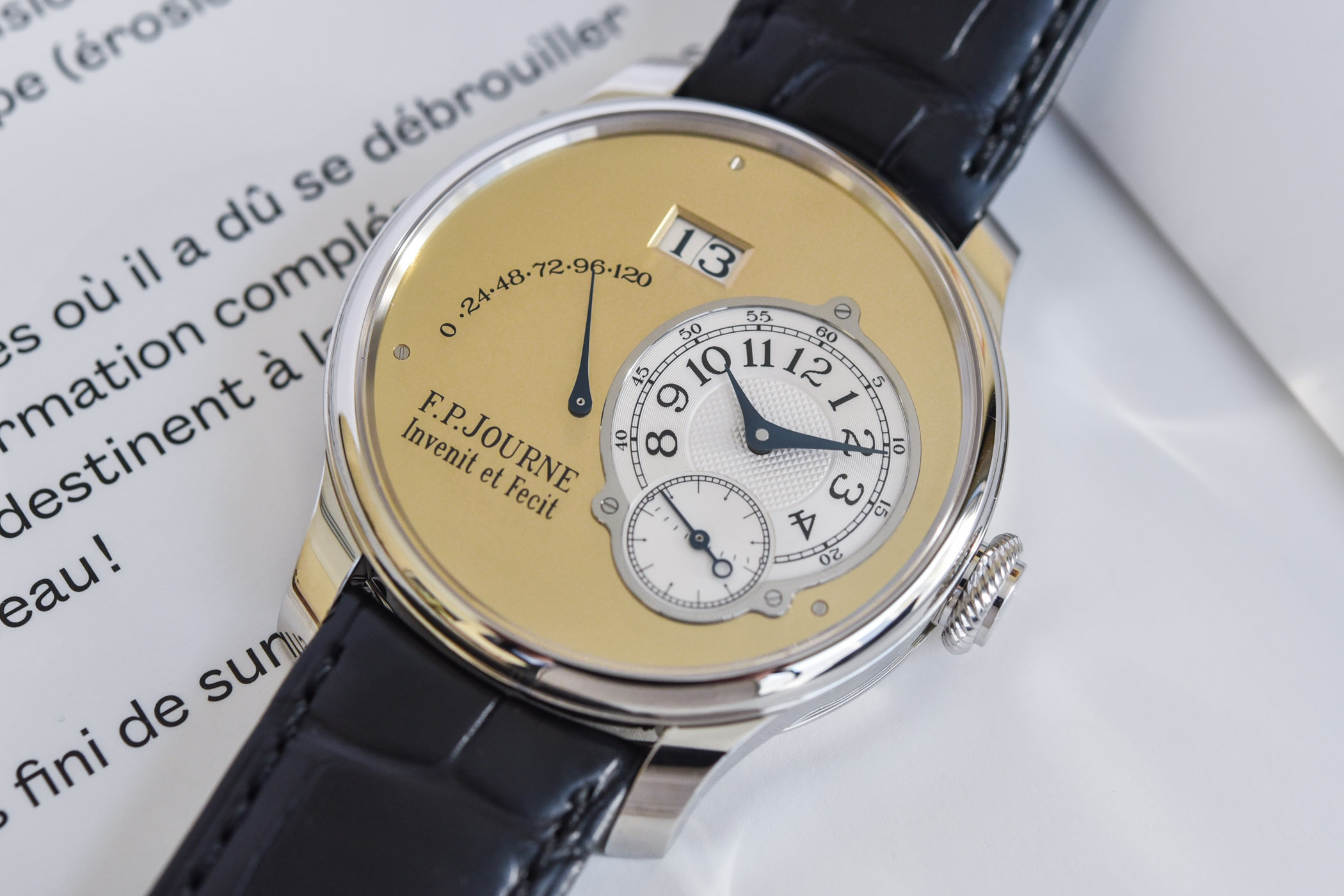
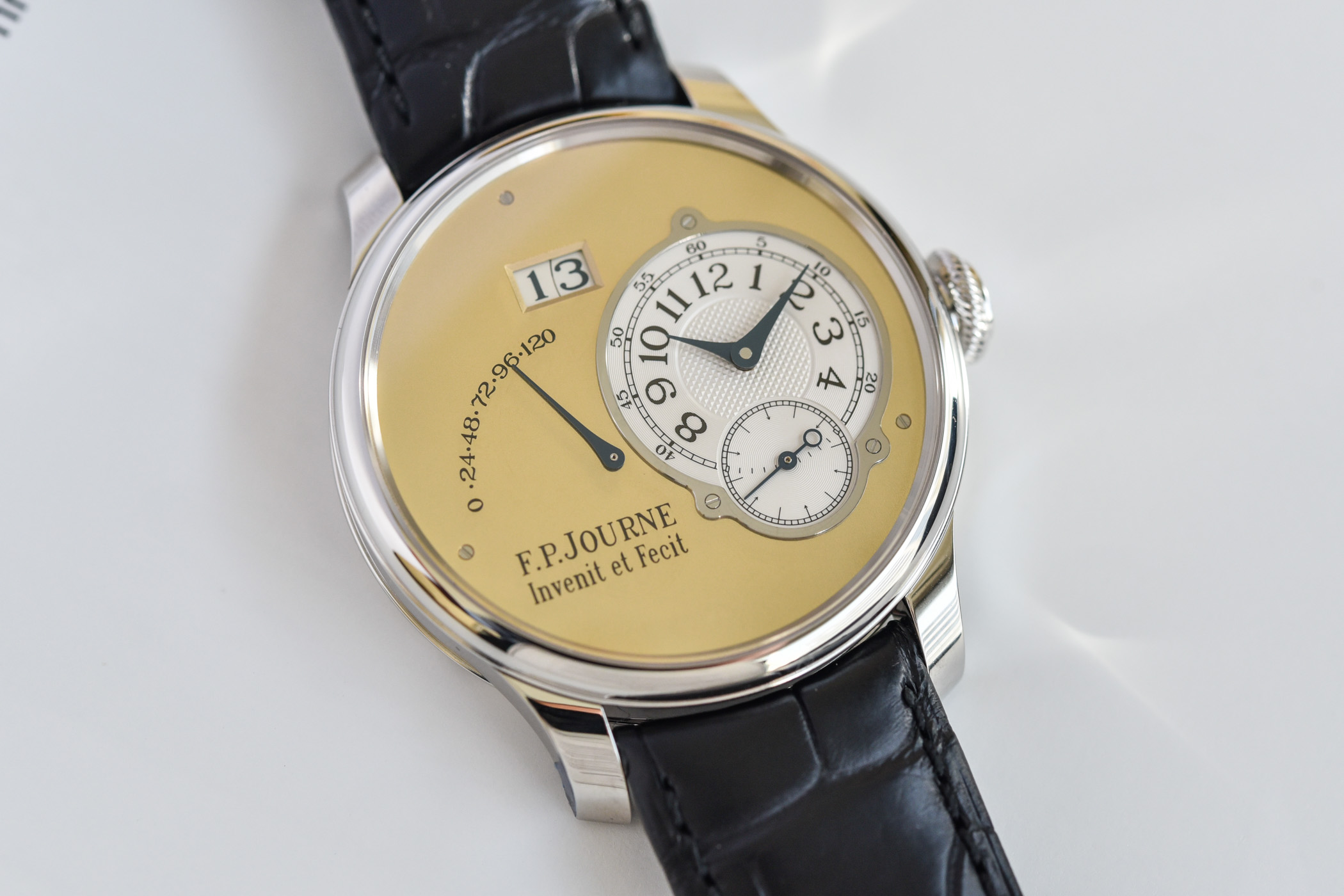
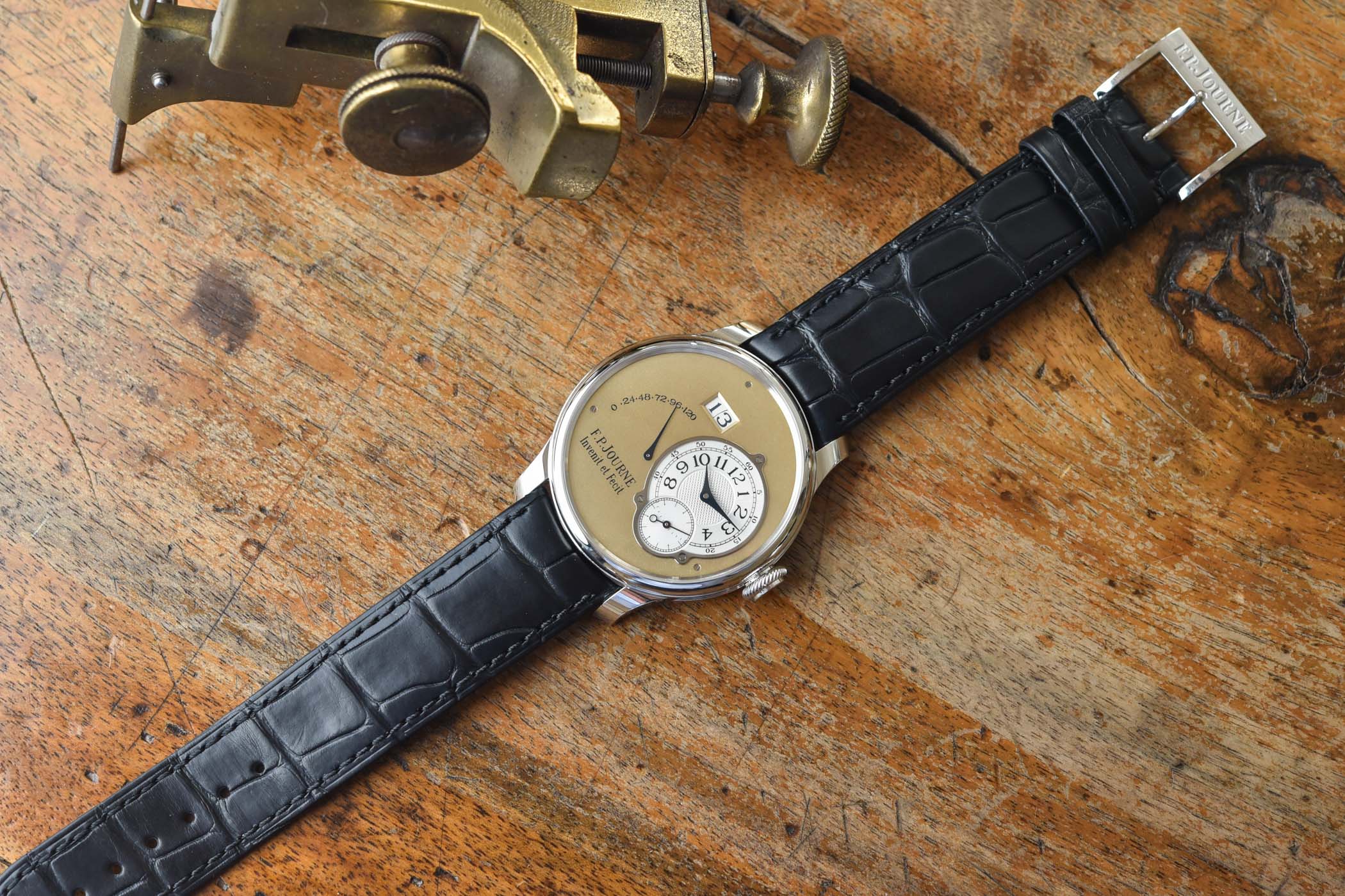
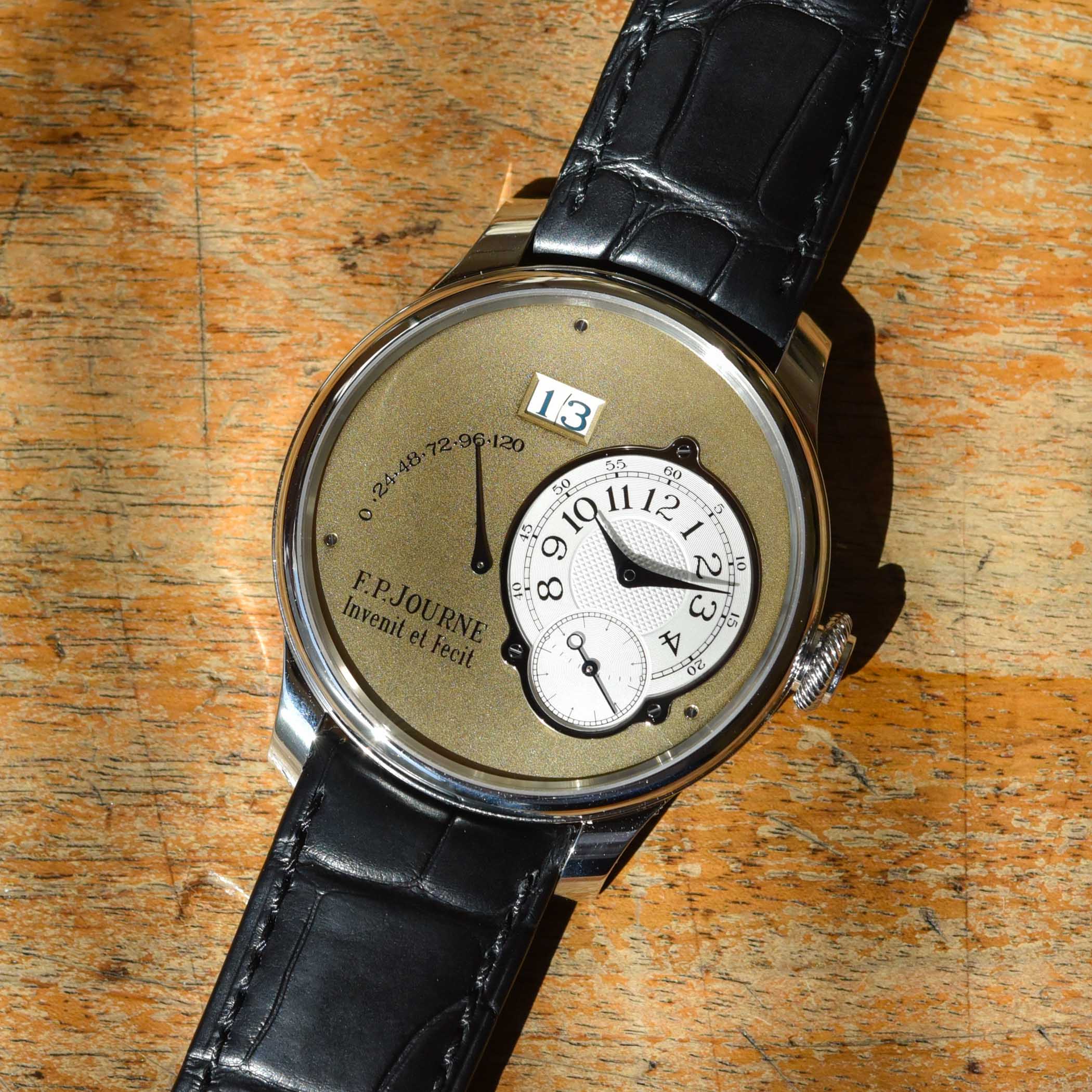
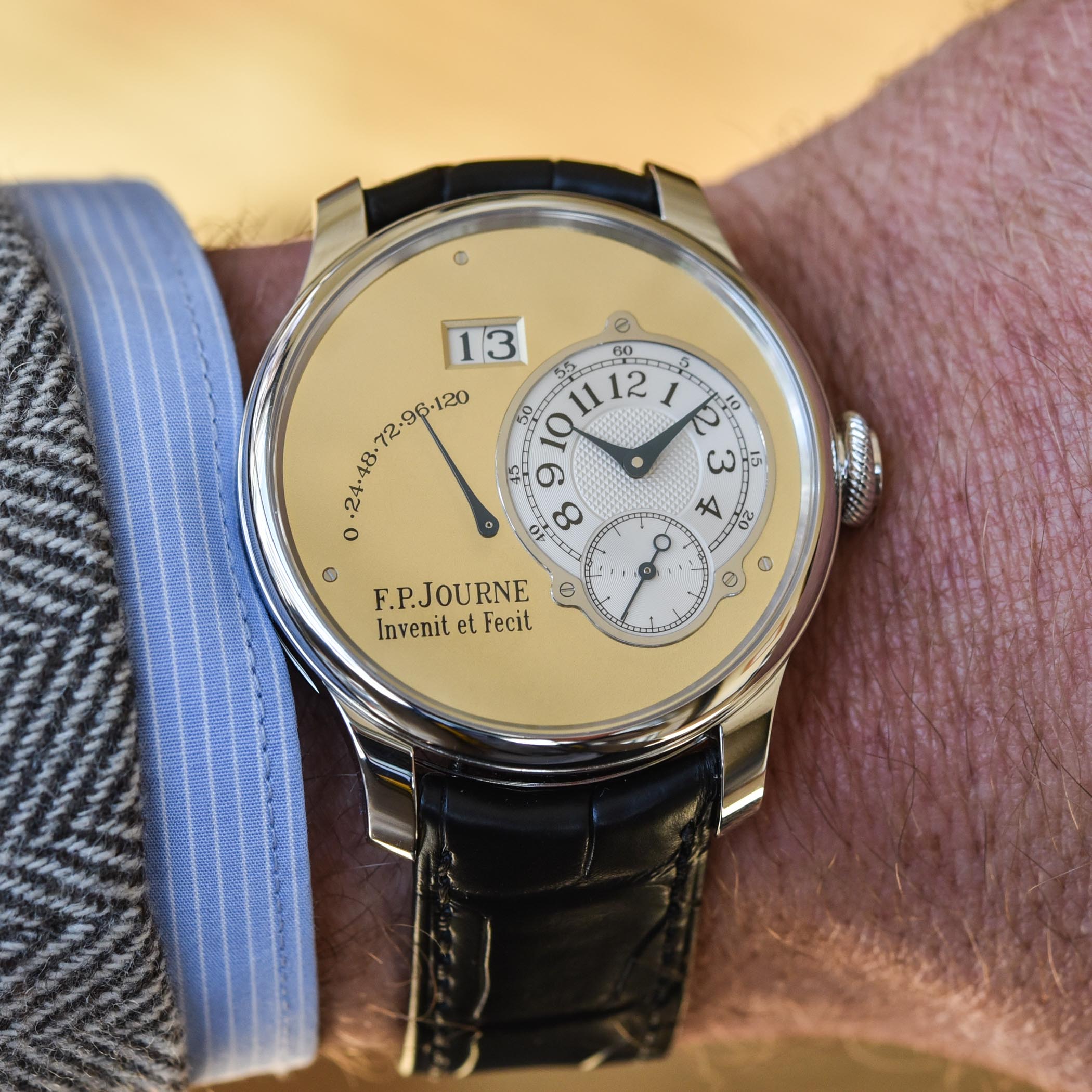
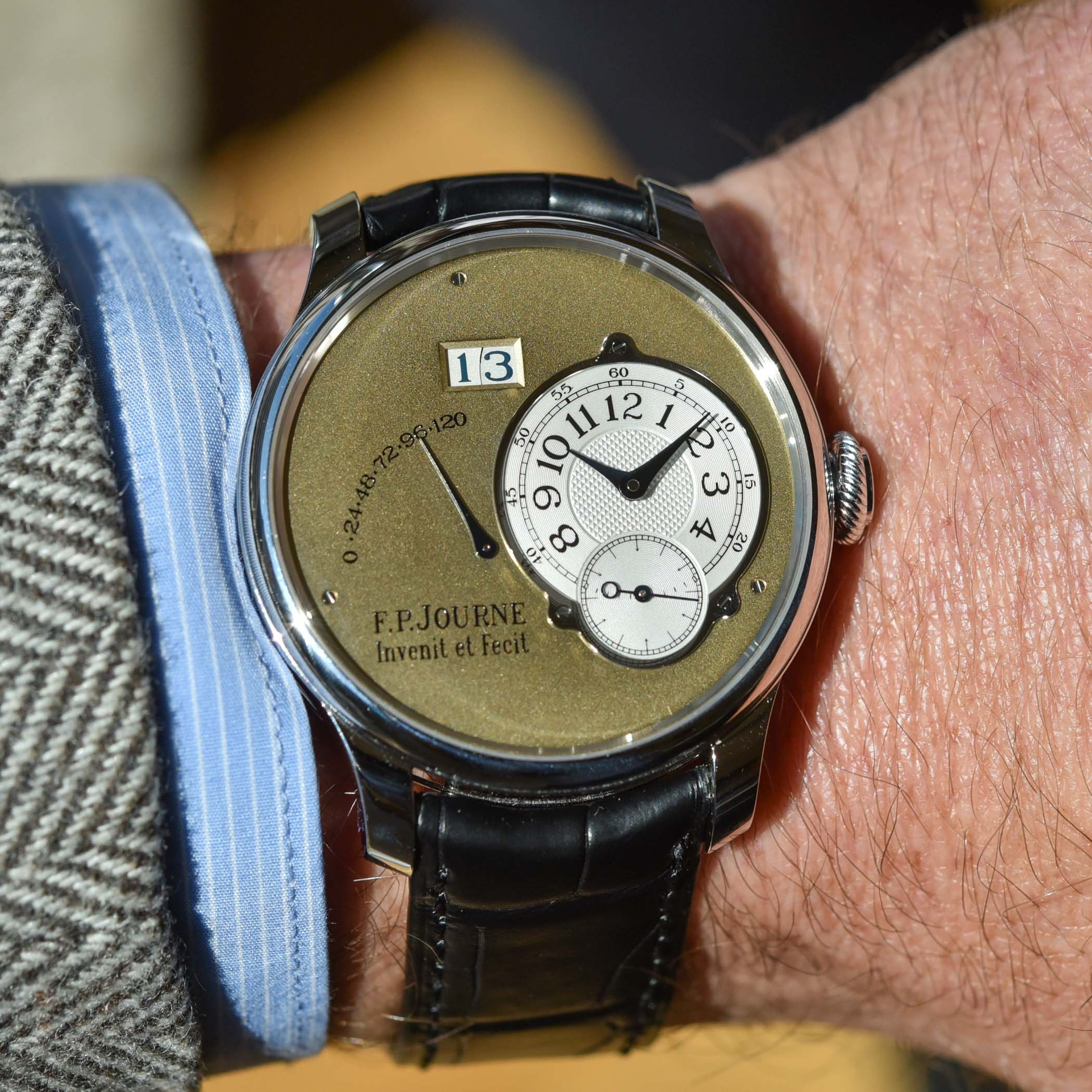

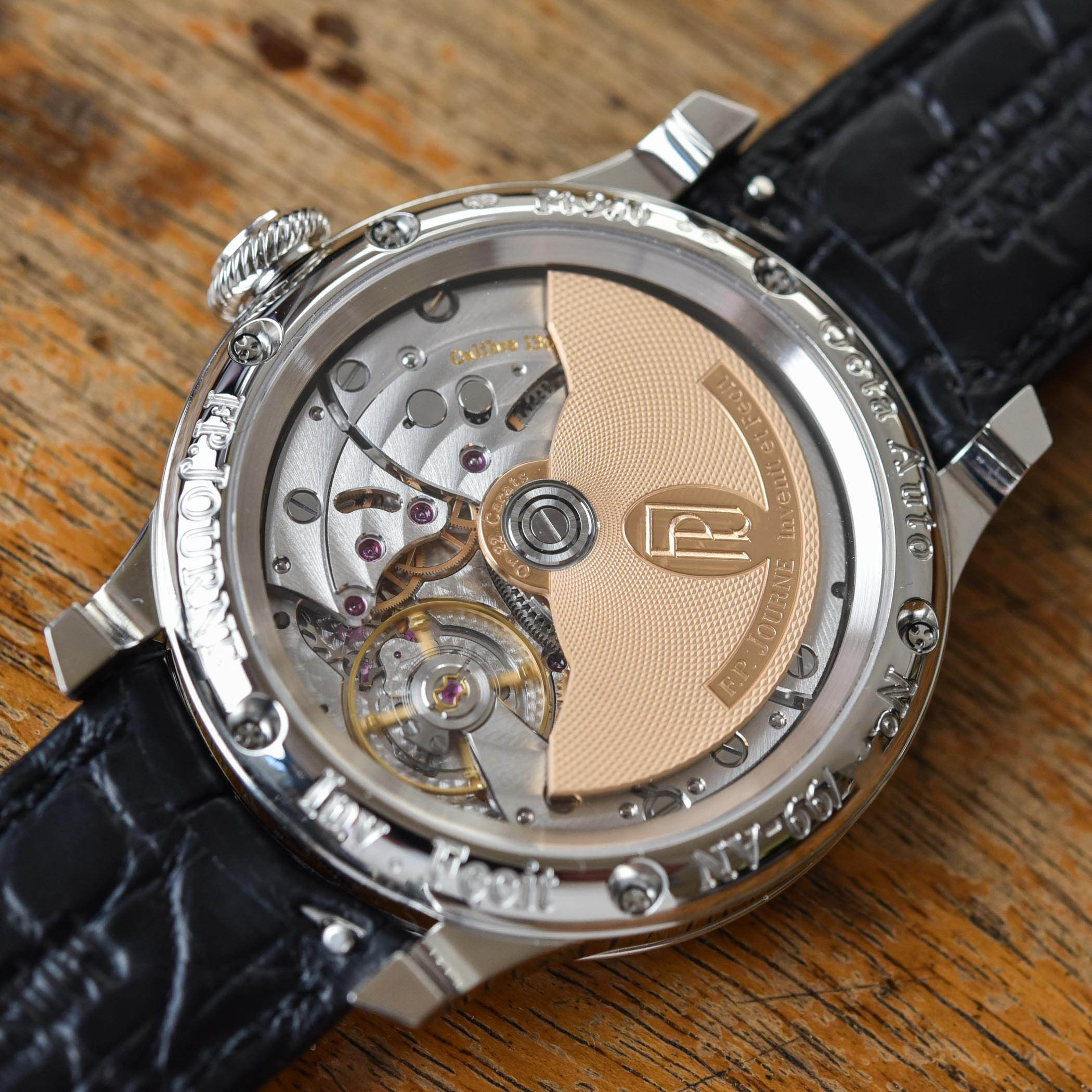
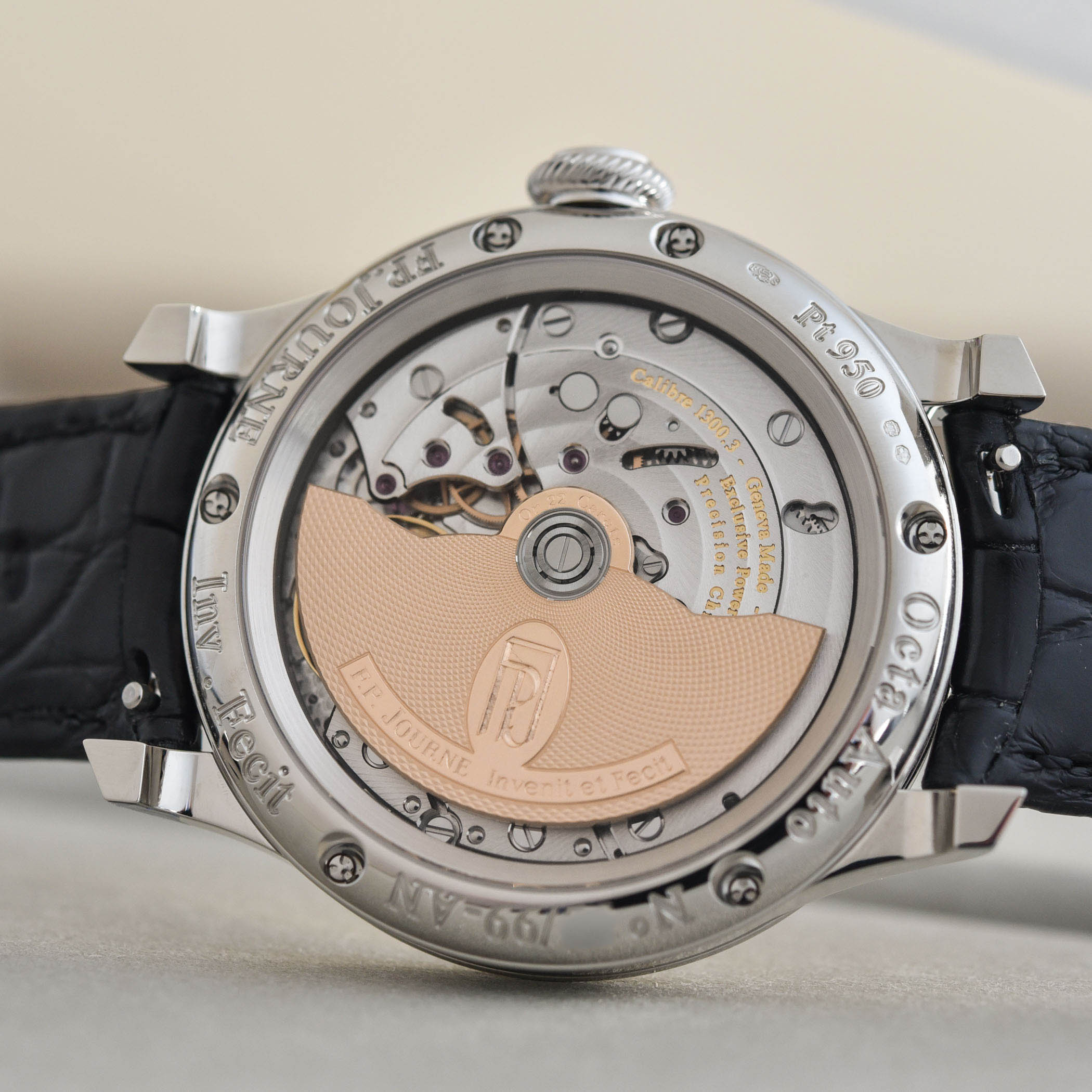
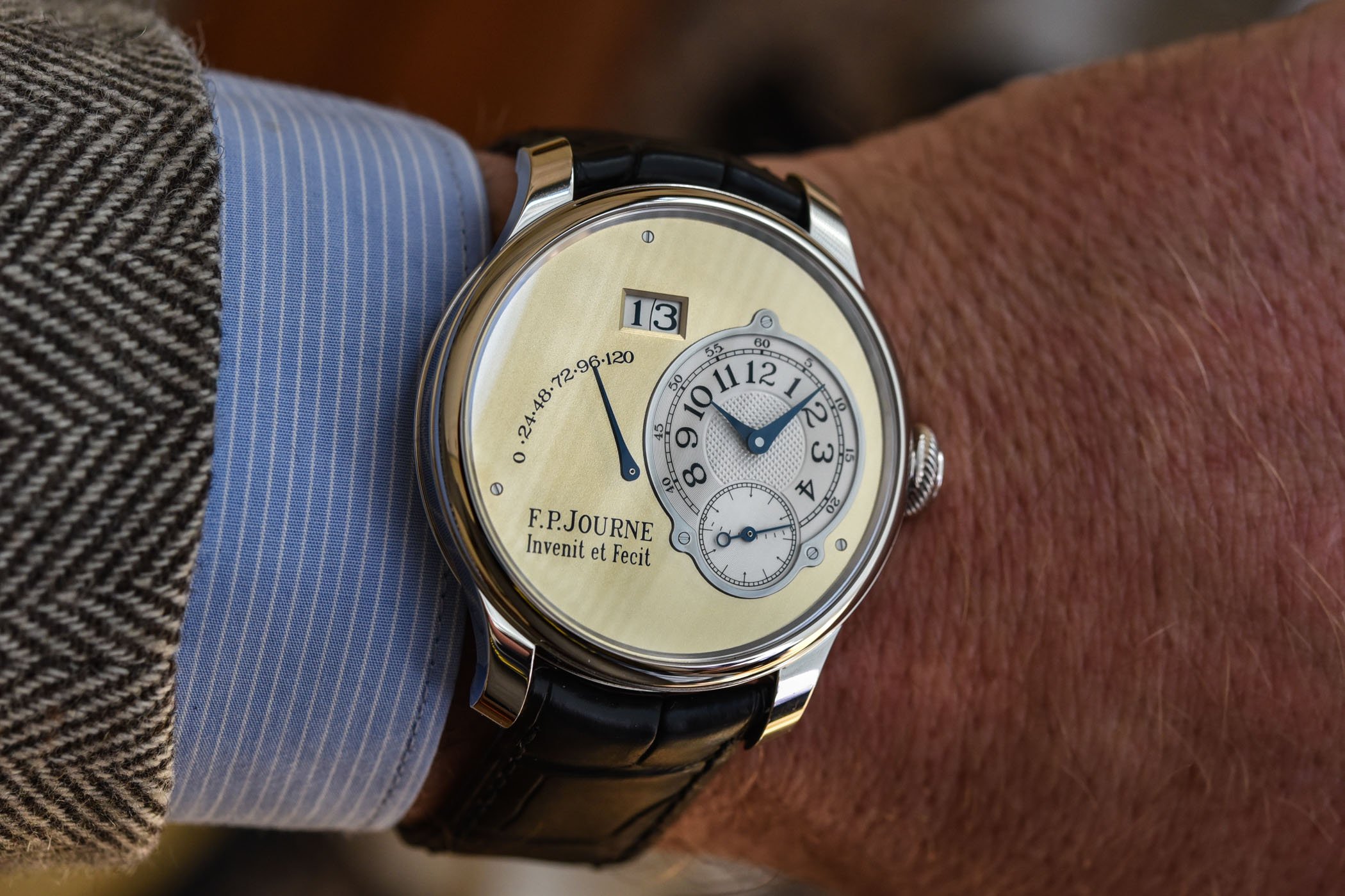



5 responses
It is, I think, my favourite Journe piece. Just perfect.
Is it really twenty years since these first movement went together with 2892 parts. Time flies
If I was a older trust fund baby , this would be on my short list of dress/ casual watches. I think it works in both realms in a smooth fashion.
Everything I want from an FPJ and more. This is a serious piece that’s fib, elegant, casual, special and rare.
Hello Rapwatch. I am curious to know where you read about ETA 2892 parts?